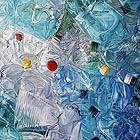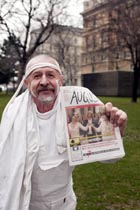
translated and summarized by: Liz Wollner-Grandville,
English summary May 25 - 30
hilger contemporary: Julie Monaco _579
... the most compelling whiplash – and the strongest wing*
While Julie Monaco’s paintings were always reduced to structures, manifestations of landscapes and natural forces, fire, clouds, the sea – she now goes one step further into abstraction:
As if zooming onto a fractal, she immerses into the “elements” of her earlier works, disassembles part of her paintings to uncover digital layers and reconfigures them.
This results in “non-photorealistic renderings” as large-format, contrasting black and white, classical silver gelatine prints that suddenly reveal figurative silhouettes and “surreal” structures, reminding of Max Ernst’s frottages.
Julie Monaco reduces the natural template until only a wing attrition of transcendence remains discernible; limiting herself to computer generated production of artificial art in order to produce her personal abstract (un)reality of the poetry of the imaginary.
By Renate Quehenberger
hilger contemporary
1010 Vienna, Dorotheergasse 5, until 16.06.09
www.hilger.at
*The title refers to Nietzsche's quote: "Belief in ourselves is the strongest bond, the most compelling whiplash - and the strongest wing." (14, 255, Nietzsche, legacy, fall 1880)
Stadtgalerie Schwaz: The Rabus Family – Alex, Renate, Léopold, and Till Rabus
Sum of its parts
Léopold’s hamster did not survive its plunge from the balcony - now a rather depressed depiction of the animal can be seen on a drawing. Fortunately, all other family members are alive and well: Alex, the father, Renate, the mother, and the sons Till and Léopold Rabus, the Swiss artist clan from Neuchatel, who have been jointly invited to exhibit their works. Compared to 2006, when the Rabus’ viewed this kind of a show with scepticism, their thirst for adventure now predominates their fear to be viewed as an attraction. All four of them posed more or less enthusiastically for the “family portrait”, which resembles a colourful kaleidoscope rather than a classically curated exhibition. Alex Rabus faces the horror vacui with his exuberant and detailed painting style, drawing from a plethora of art historical references and outing himself as an eco-warrior. Renate Rabus applies artisan craftwork to textile art and creates elaborate stitched works inspired by Schubert’s Winter Journey. And finally, the brothers: socially formed through their artist home, working together in a studio, and discovered by gallery owners in a twin pack. But despite all this, they each favour rather contrary forms and ideas: Till Rabus, born 1977, takes a savage look at the consumer and throw-away society, a pile of black garbage bags experience something like estrangement in their hyperrealism. Leópold, born 1975, is the more popular one. Originally he wanted to become a clown; the tragic-comical remains part of his work. In “Le point d’eau” time levels superimpose directly into the deformed fingertips of the main figure. Morbidly distorted index fingers recur in an installation created with oval wooden frames - together with the above-mentioned sad hamster as well as braided decorative objects made of real hair. They resemble relics made of hair belonging to deceased ancestors used in folk-like traditions – even beyond relational circumstances.
By Ivona Jelcic
Stadtgalerie Schwaz
6130 Schwaz, Palais Enzenberg, Franz-Josef-Strasse 27, until 06.06.09
www.galeriestadtschwaz.at
New Museum: Younger Than Jesus
The new ideology of salvation
“Younger Than Jesus” is the remarkably bizarre title of the new Triennial of young art at the New Museum in New York. The title was sharply criticized: why does the salvation myth have to serve for a “Best Of show”. One could have at least made use of van Gogh to advertise the motto “young and effective”. But this Triennial is obviously not interested in discussions on identity politics or visual presentations of globalisation in art. Instead, the exhibit presents itself as a research project focussed on artists born around the year 1980.
Museum director Lisa Phillips and the curators substantiate this with surveys on the so-called Millennials, Generation Y, and Generation Me; and they underline their choice with unsophisticated and trivial statements such as: nobody has achieved more by the age of 33 than Jesus. An international network of over 150 curators and informants were involved in the preparations.
More than 50 artists from China, Algeria, Germany, India, Romania, Turkey, and Venezuela present their works. Among them Tris Vonna-Michel, who lives and works in London and Berlin, and whose walk-in installation attracted attention at the last Biennial in Berlin, Ahmet Ögut, with his clever-ironic interventions on traffic and speed, as well as Jeffrey Inaba, Ugo Rondinone, Keren Cytter, Cory Arcangel, Anna Molska or the Romanian Ciprian Muresan.
Behind all of this is the attempt of a thematic categorisation. For example with the title: “IMAGINING THE FUTURE: Possible worlds and fantasies of identity”. Typical for this is the retro-futuristic video by Ryan Trecartin (born 1981), reminding of low-technology computer games as well as YouTube aesthetics and Flickr. Other chapters are called: “THE ROMANCE OF OBSOLESCENCE: The artist as archaeologist” or “REWRITING THE PAST: What do we remember? How do we forget?”
Great effort was made to convey contemporary art to a broad audience with this clever and diverse exhibition– this actually being the principal duty of Biennials and Triennials. But it is remarkable how the activation of the myth of being “young” combined with “successful” correlates with the ideological attempts to reconstruct the USA as the superpower of goodness.
It is the New Museum’s historic mission to concentrate on presenting young artists. This was already one of the founding motives of the museum initiated by the Whitney-dissident Marcia Tucker in 1977. In the future, the Whitney Biennial, which concentrates on US art, will continue to be challenged.
By Roland Schöny
New Museum
NY 10002 New York, 235 Bowery, until 05.07.09
www.newmuseum.org
Secession: Pawel Althamer and Others
Joseph Maria Olbrich and Südtirolerplatz-Günther
The concept reminds of the hands-on art of the 90s, of New Genre Public Art: in the garden of the Secession, Pawel Althamer initiated “a public space for communication with simple means”. A campfire symbolizes the archetype of a “round table”.
All of this sounds rather antiquated, but it works. Althamer’s simple intervention – creating a tunnel through the building of the Secession and thereby making the rest of the building inaccessible – is rather irritating. People are found sitting or lying in the garden. Althamer invited various groups including homeless, women wearing suits, or tourists with folding maps. Students constructed a shelter for Südtirolerplatz-Günther – he enjoys talking to people and keeps communication flowing. Donat Grzechowiak’s skeleton of a boat can be found hanging between trees, heaps of wood are nailed to one another and placed on the trees, and the word “love” is mowed into the lawn, decorated with gerbera – and there is an abundance of graffiti, created by children, throughout the tunnel.
As with every exhibition at the Secession, the building’s architecture plays a major role. The graffiti does not sprawl onto the façade – Olbrich’s aura is too strong. And if you stay in the garden for a longer period of time, you are practically forced to look at the the back side of the façade more closely.
Admittedly, Althamer’s project is capable of conquering public space, but one should have refrained from painting over the sexist scribbling in the tunnel. If the absolute “surrender, respectively transfer, of authorship to others” is really intended (as stated in the press release), then these kinds of things must be accepted – even if they might be displeasing.
By Nina Schedlmayer
Secession
1010 Vienna, Friedrichstrasse 12, until 21.06.09
www.secession.at
Mehr Texte von translated and summarized by: Liz Wollner-Grandville


 Teilen
Teilen





